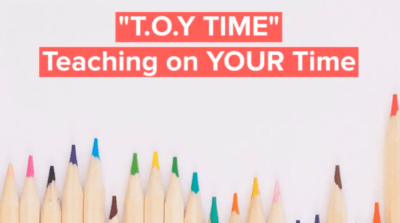
How do you teach 212 students from a distance? Expanded-Impact Teacher Jimmel Williams says you listen carefully to your students’ needs, and keep your teaching — and your high expectations — largely the same.
Williams, who teaches eighth- and ninth-grade math in Charlotte-Mecklenburg Schools and was a 2017-18 Opportunity Culture Fellow, is still figuring out exactly how he wants the “live” teaching component to work with so many students, but he has a wealth of materials — and individual connecting with students — to draw on in the meantime.
Before schools closed due to COVID-19, Williams’ classes involved his teaching half the class directly for half of the period while the other half of the students worked in a computer lab; students swapped places for the second half. During lab time, they worked under the supervision of his reach associate (an advanced paraprofessional) on skills practice, projects, and taking notes on instructional videos Williams produced.
He also supported the sixth- and seventh-grade math teachers, and is continuing that support through regular online team and one-on-one meetings.
Williams spent the first two at-home days contacting each student.
“I gave them the ‘be encouraged’ and all of my other little sayings … I know that they’ll miss that, because that’s what they were talking about — ‘I’ll be encouraged, Mr. Williams, all the best,’” he said.
Keeping those personal connections going will be one of the biggest challenges, he said. As he makes more videos, he is working to put a lot of his personality into them, and he stays available to students through messaging and calls.
Williams focuses on breaking work down to aid student comprehension. Just before we spoke, he sent one student eight photos to show the steps of a problem she was struggling with. When he sees several students struggle with the same issue, he makes a video on it for all students. (He also often uses DeltaMath videos.)
Williams can track their progress and schedule a quick meeting if he sees a student struggling too much. He found that live options like Zoom work best for this individual instruction or for small groups, and he relies on Remind for text messages that help students stay on track with due dates and for sharing photos of their work.
He previously had a website for students to see assignments, major objectives, and deadlines. But students asked him to move everything onto Canvas, and they told him to simplify the presentation, with expandable menus that kept the assignments from feeling overwhelming.
He has begun using Canvas Conferences (similar to Zoom). “For the students who can’t quite get the math using my videos, I have created Canvas Conferences for each class at designated times. I actually like Canvas Conferences a little better because it automatically uploads the video to my files on Canvas so I can include it in my online modules effortlessly,” he said.
Williams wants to balance the concern for not overwhelming students with the high expectations they know he holds for them. Many of his students come from difficult home environments or economically disadvantaged households; some, he said, “came to our school as an escape from their house.”
“I just told the kids, ‘I’m here and I’m understanding, but … [I] must love you enough to give you all of the things that are required to not just pass a test but to be able to be successful in future classes—you’ve got to do the work, you’ve got to push, you have to fight.’ … If we’ve got to figure it out, we can talk, we can work it out,” he said.
Williams also surveyed his students; while at-home school isn’t the same, they said, they overwhelmingly agreed that they were learning. The survey also showed that “they really miss their peers; they miss being able to just laugh and cut up. They’re also very concerned and very anxious, [but] a lot of students said it makes them feel less anxious when they are doing work.”
Williams echoed what many multi-classroom leaders and principals said in recent interviews: Despite the general dislike of high-stakes end-of-year/grade (EOG) tests, their teachers and students feel dismayed that they now can’t show on the tests the high growth they expected.
“This group of students was highly energetic, and most of them really were motivated to do well, so I’m a little sad,” he said. “It’s not just about taking a test at the end of the year; it’s also about validating and showing them ‘hey, you thought that you would never pass the EOG at the end of the year.’”
As expanded-impact teachers plan for the possibility of school closures extending beyond spring, Williams said, they should consider:
How to work best with a reach associate (RA) to reach all students well. Williams gets strong support from his RA, and would have her lead small groups on Zoom. This year, she sat in one class period with him and took notes and did the classwork, to deeply understand it. “She’s been able to accurately support students in very complicated topics,” he said.
How to balance students’ needs for schedule flexibility with a standardized class schedule. Students may have responsibilities, such as caring for siblings, that make attending an online class more difficult, yet they need that structure and practice in meeting such expectations, Williams said.
How to settle students in to full-time distance learning. Williams stresses routines. “It makes them feel less anxious when they are doing work,” he said. “I feel like they need to be on the schedule that they had in school. … I was just like, get a routine. I did a video about all of that — be very deliberate about what you are doing.”
How to shift from hands-on group projects to at-home projects. Williams is still working on this. “I’ve realized that I rely a lot on paper and things like that, physical touch, manipulatives. So I just have to be very creative.”
Finally, Williams wants the public to understand how hard all teachers are working now; some friends mistakenly believed otherwise.
“I told them that’s far from the truth, because I’m still engaging, I’m still emailing almost half of my students every single day or texting all of them on a daily basis, because they really do have a lot of questions,” he said. “I’m teaching still.”
In the first week and a half at home, Williams sent more than 2,000 emails and created 45 more videos.
To see more about Williams, watch short video clips that are part of our Instructional Leadership and Excellence resources, including Help Students Internalize and Reach Goals, Back High Expectations with Steadfast Support, and Use Available Data to Plan Ahead and Set and Impart High Goals.
Editor’s note: This perspective was first published by Opportunity Culture. It has been posted with the author’s permission.




